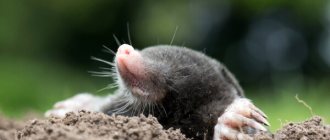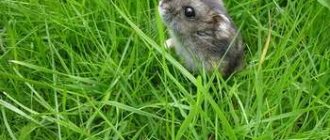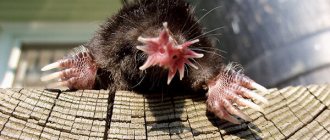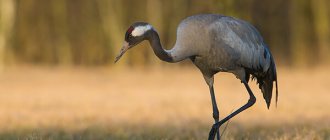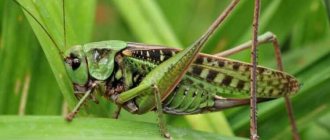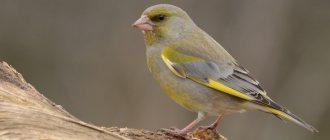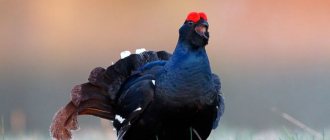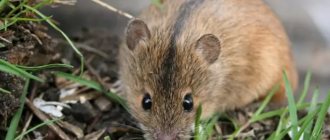- Mole habitat
- What does a mole eat?
- Can the mole see?
- The benefits and harms of moles
A small mole animal that lives underground, has an elongated body up to 20 cm long, covered with soft velvety fur of a dark gray or black shade. Due to the fact that the pile does not have any specific direction, the mole can easily move underground in any direction. This is a special adaptation to the mole's habitat.
The mole has well-developed front paws, spade-shaped with long claws. With them he rake the ground, making underground passages up to several tens of meters long per day. At a depth of about a meter, the mole makes a nest, usually under the roots of trees, lining it with moss and leaves.
Appearance description
The behavior and appearance of the mole have not been studied in as much detail as we would like. The fact is that the mammal chooses hard-to-reach places to live. But still, biologists were able to track this animal in the wild.
It is in appearance that the relative nature of the mole’s adaptability to life underground is revealed. The animal has strong front legs, which allow it to constantly dig the ground. The rounded hands resemble oars in appearance, and the wide palms are turned outward. The fingers are spread apart and end in long, strong claws.
The hind legs are not so strong; with them the mole only scrapes loose soil out of the hole. A long muzzle with an elongated nose helps the animal find food and safe places by smell. The body is covered with a short fur coat, which does not interfere with movement through narrow underground passages.
The wool grows upward and can bend in any direction. The common mole is black-brown or dark gray in color. The mammal has eyes, but they only distinguish between light and darkness. The animals are practically blind, although they do not need vision underground. The structure of the eyeball of moles differs from the organs of other animals . They do not have a lens or retina . Movable eyelids and thick fur protect the eyes from soil getting into them. Mammals have a well-developed sense of smell.
How a mole sees
Perhaps the most interesting question concerns the mole's vision, or more precisely, whether the mole has eyes at all. In the cartoon about Thumbelina, we are used to seeing a blind mole with glasses. Although many people think that the mole is completely blind, this is not true. The mole has eyes, but they are very small and completely useless underground, which is why the mole has poor eyesight. Apparently, adaptation to the mole's habitat led to the disappearance of the eyes, but the development of the sense of smell and touch, which allows one to find food in pitch darkness by smell and touch.
Animal species
In total, about 40 species of moles are known. Some of them are quite common, others are very rare. They differ in appearance, habitat and behavioral characteristics. Main types:
- European or ordinary;
- Japanese shrew;
- American;
- Siberian;
- Caucasian;
- Ussuri mogera;
- star-nosed
The first species of animal is found in Europe, which is why it received its name. The common mole grows small: body length - 16 cm, weight - no more than 100 g. The Japanese shrew mammal is even smaller, and it is found on the islands of Shikoku, Tsushima, Honshu and Dogo. On the mole's muzzle there is a long proboscis with hairs that capture air vibrations. In search of food, the shrew can climb bushes and trees.
The American mole lives in Canada and the USA. These are black and gray animals with thick fur. The length of their tail sometimes exceeds the size of their body. The animal swims well and can climb trees. The description of such a mammal is similar to the Japanese shrew; biologists consider them to be related species.
The Siberian or Altai mole resembles the European one. But females are very different from males. The round body of males reaches 20 cm in length, they weigh only 150 g, and females grow smaller. Males are usually black or brown, females are gray. This species has no ears at all, but the nose has turned into an elongated proboscis.
The Caucasian mole's eyes are covered with a film. But it has a more subtle sense of smell than other species. The black, silky coat fades with age. The mole, which is called the Ussuri mogera, looks very interesting. This is a large animal compared to its other relatives: body length - 21 cm, body weight - up to 300 g. This mole has underdeveloped eyes, and it is a rare species, therefore measures have been taken to protect it in the Far East, Korea and China.
The North American star-nosed bat or star-nosed fish is so named because of its unusual nose. This part of the body consists of many tentacles, each of them has olfactory receptors. The animal loves water very much and often lives near bodies of water. He swims well and can dive.
Habitat
The mole spends almost its entire life in underground burrows, but not every soil is suitable for it. The animal carefully chooses its place. It prefers moist and loose soil. Another habitat is simply not suitable for the mole: it will not be able to break solid lumps of earth.
But sometimes soil mounds are found in fields and meadows. The mammal usually throws excess soil upward. Mole rats can be active both at night and during the day. They don't care what time of day it is, since their eyes don't distinguish between darkness and light well.
The biological rhythms of the mole are different from other animals. The mammal alternates periods of activity and rest. It prefers to work for four hours and then sleep for three. It is not easy for a mole to move underground, so it does not make long movements. Only on hot summer days does the animal break through passages to reservoirs.
Mammals do not like to be in the company of their own kind. These are loners, so they are ready to defend their chosen areas. Moles have a difficult character and often show aggression. If they had to share the land with neighbors, then the passages are dug so that they do not intersect with the paths of another individual. But if one animal dies, the second tries to quickly occupy its territory. As a mark, moles secrete a special substance - a secretion with a pungent odor.
Mammals do not hibernate in winter. The inhabitants of the underworld prefer to spend their time differently during the cold season. They dig deep holes and fill them with supplies. Only underground can moles spend the winter while remaining safe. If they get to the surface, they will become prey for eagle owls, foxes and martens.
What does a mole eat?
There is a wide variety of food underground, including earthworms, the larvae of various beetles and butterflies, small insects, slugs, spiders, as well as small frogs and lizards. The mole eats all this.
Since this small mammal has very active metabolic processes, the mole is forced to eat quite often, and in winter, contrary to popular belief, the mole does not hibernate at all, so the need for food, although small, is still there. In order not to die of hunger, he prepares food for himself in the fall. Basically, the reserves consist of earthworms, which he bites through the head to prevent them from crawling away. The lifespan of a mole on this diet is about 5 years.
Burrow construction
The mole spends most of its life underground. Only to develop a new area does it come to the surface. The animal digs two types of tunnels:
- veins;
- search engines
The first ones are also called nests; the mammal rests and hides in them during the cold season. They lie at a depth of 10−90 cm, and their diameter is only 5 cm. Closer to the surface, the mole makes search passages. He digs them so that earthworms and other underground invertebrates live nearby. The network is extensive, it can occupy significant areas - hundreds of square meters. Moles leave traces behind them: soil rollers that appear due to the swollen arches of passages.
The animal digs the ground with its front paws, and rests against the already compacted walls of the hole with its hind paws. At a depth of 10 cm, the mammal can no longer raise its head, so it throws the soil to the surface.
These heaps are called molehills; they reach 15–25 cm in height and up to 1 m in diameter. They are usually gathered in small groups. Molehills are the only sign of the presence of moles on the site that a person can detect.
mole's adaptability to the environment
Appearance The appearance of ordinary moles is typical for the family. They have an elongated and rounded body, a greatly shortened neck and an elongated muzzle, flattened from top to bottom. The nasal proboscis is supported inside by a special thin bone os praenasale; it ends in a dense bare plate. The limbs are greatly shortened and adapted for a burrowing lifestyle. The front paws have wide, spade-shaped palms, turned outward and armed with powerful claws. There are no external ears. The eyes are vestigial and often hidden by the skin. The hairline is short and thick; color black, black-brown, less often dark gray. Light or spotted moles are occasionally encountered. The mole sheds up to 4 times a year. Medium sizes: body length from 9 to 23 cm. Tail length from 1.5 to 3.6 cm.
Habitat These are the most common, widespread moles, found in a wide variety of landscapes (especially numerous in forest and forest-steppe zones). They prefer moist, but not swampy soils that are easy to dig. They lay a complex system of feeding and residential tunnels underground. When digging deep passages, characteristic piles of earth are thrown to the surface - molehills. Active around the clock, voracious. The main food consists of earthworms and other invertebrates, including various agricultural and forestry pests. The female bears one litter per year. They are of great benefit by creating ventilating tunnels, as well as loosening the soil and destroying harmful larvae of various insects, as well as mole crickets.
Source
Mole nutrition
Mammals are considered insectivorous predators. Animals obtain food from loose soil, and they find it using their sense of smell. The animal’s nose is adapted to distinguish odors at a distance of tens and sometimes hundreds of meters.
Earthworms, slugs, beetle larvae - this is what the mole eats. Although his diet also includes other food:
- frogs;
- ants;
- small rodents;
- lizards;
- large beetles.
Moles do not eat plant foods, so they do not eat crops when they dig holes in gardens and orchards. Moles have a fast metabolism; they need at least 150 g of live food per day.
At the end of autumn, the mammal begins to prepare supplies for the winter. They look for a victim, immobilize it with a bite and drag it to their hole. Near its nest, the animal digs several storerooms and connects the home to them with different passages. Moles fill the storage to the maximum - they store at least 2 kg of food for the winter .
The benefits and harms of moles
The mole brings great benefits to the soil, loosening it and providing a flow of air and moisture, as well as destroying many agricultural pests. However, there is also harm from moles for garden trees and shrubs, the roots of which are gnawed by animals. They also destroy earthworms, which are also good for the soil.
In order not to kill the moles themselves, but simply to force them to move, humane methods of mole control are used, for example mole repellers such as Tornado.
| Mole repeller (anti-mole) Tornado OZV.02 The repeller automatically, after a certain pause, produces body vibration and sound. This frightens the rodents living in the soil next to OZV.02, and they leave the protected area in search of a quieter place. more details >> |
Mammal Reproduction
Moles are unsociable, but during the breeding season they make exceptions and show interest in individuals of the opposite sex. Males look for partners underground, where mating takes place. But after that they prefer to live as before. The males return to their nests and are completely uninterested in the female and their young.
The mating season repeats every year, and its seasonality depends on the habitat. It lasts only 2-3 days - until the female responds to courtship and agrees to mate. The mother carries the child for 40 days, then he is born. This is a poorly developed, hairless and completely blind mole. From 3 to 9 babies can be born at one time. Moles belong to the class of mammals, so females feed them with their milk, which is quite fatty.
The cubs develop very quickly; after just a couple of weeks they turn into real moles. The babies begin to eat earthworms. And a month later they dig their first passages underground. At this age, the child leaves his mother and learns to get his own food.
The new generation leaves the parental nest and is looking for areas to settle. Females may even bite the cubs if they want to return home. The life expectancy of a mole is 6-7 years. But in the wild, mammals die earlier due to attacks by predators and diseases.
Beneficial features
The European mole has useful traits. They are expressed in the fact that the animal was previously an object of the fur trade. The mammal has beautiful and durable fur. At the beginning of the last century, moles were hunted for their valuable skins. But the massive catch led to the fact that the animal began to need protection. In 1928 alone, about 20 million skins were harvested.
In the Soviet Union, mole fur clothing became popular in the 1980s. But today in Russia mammals are not hunted, which is why their population has grown. Their numbers also increase due to mild winters, the construction of greenhouses, and the care of lawns and flower beds .
Moles improve the condition of the soil. They make it loose and saturate it with oxygen, which can save the earth from the formation of swamps. Animals destroy pests because they feed on them. Moles eat chafers, mole crickets, and insect larvae.
